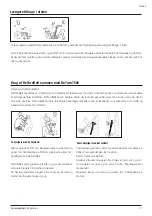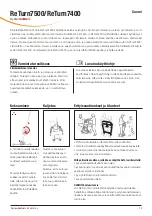
English
The feet are placed one on either side, see foot markings on base plate.
The user’s weight must be centred on the product’s support surface (all
weight between the wheels); i.e., the user must be in a standing position.
The user’s weight must not be outside of the support surface.
Chassis and placement of feet
Lower-leg support
Brakes
There is a brake for each wheel. With your foot, press down
on the red marking on the brake plate. Press all the way
down.
To release the brake, press on the brake plate so that it
resumes its original position (green marking); ensure that
the wheels roll freely.
Testing standing function
ReTurn is ideal for testing a user’s
standing function in cases where
there is uncertainty as to whether
the user is able to rise from a seat-
ed to a standing position.
Training standing function
ReTurn can be used to train the
user’s standing, sitting and sit-
to-stand function. To measure
improvement, use a stopwatch or
clock with a second hand to time
the user.
Transfers
Bed to wheelchair
Place the wheelchair at some distance from the bed to allow enough working space. Lock the wheelchair wheels. Place the
user’s feet on the base plate. The user grasps the raising ladder, leans forward, and then raises himself/herself.
Pull the ReTurn back somewhat, and then steer in towards the wheelchair.
Position the ReTurn close enough to enable good placement in the wheelchair. The caregiver applies counter pressure
before the user sits down.
Adjust the lower-leg support so that the upper edge of the
plate is about 3 cm/two fingers below the lower edge of
the kneecaps. Pull the two pins to loosen. Adjust to the
appropriate height.
Ensure that the pins lock securely into place. The lower-leg
support can also be adjusted laterally.
4
M A N U A L System
RoMedic
TM





































